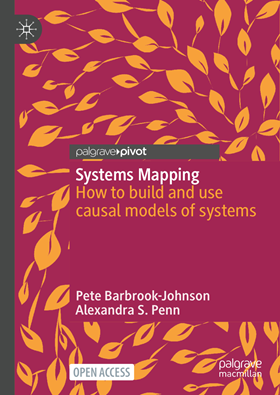
![]() Home Page
Home Page
![]() Company
Company
![]() Clients
Clients
![]() Reports
Reports
![]() CallWeb
CallWeb
![]() SampleCalc
SampleCalc
![]() EPlanCalc
EPlanCalc
![]() French
French
For every complex problem there is an answer that is clear, simple, and wrong.
(H. L. Mencken)
 Pete Barbrook-Johnson and Alexandra S. Penn have recently published an important book entitled Systems Mapping, How to build and use causal models of systems. Not only is it excellent, it is also offered in open access.
Pete Barbrook-Johnson and Alexandra S. Penn have recently published an important book entitled Systems Mapping, How to build and use causal models of systems. Not only is it excellent, it is also offered in open access.
My acquaintance with systems thinking goes back to the late 70s when my professor Réjean Landry (Laval University) taught me about causal modelling and systems dynamics. It was a fundamental revelation: one could explore and expose the workings of the social world using structured tools and, eventually, mathematical modelling. I carried on with systems dynamics and wrote a master’s thesis on the impact of various public policies on the housing market, using computer simulation (1979). I continued using causal and systems thinking as an evaluator during the ensuing four decades.
Given this personal background, it is no surprise that I enthusiastically welcome the publication of Barbrook-Johnson and Penn’s book. The text starts with a description of systems mapping and a justification for its use. It carries on with presentations of seven approaches to systems mapping, from the simple to the complicated: rich pictures, theories of change, causal loop diagrams, participatory systems mapping, fuzzy cognitive mapping, bayesian belief networks, and systems dynamics. In each case, the authors describe the method, offer tricks of the trade in the use of the method, highlight common issues, and identify the best uses of the approach. While practical in its exposé, the book paves the way to a critical assessment of the different approaches in a given situation.
There is so much that policy and program evaluators can pick up from this text. After all, causal modelling is at the core of our discipline as we strive to understand how interventions address problems, which levers they push and which would be best targeted under what circumstances and for whom. Even if we don’t resort to the most structured of the causal thinking approaches (I for one only had a single opportunity to use systems dynamics in evaluation over many many years), adopting a rich method to decipher program logic and impacts must be better than winging it in the form of a linear logic model.
Benoît Gauthier
To reach us:
General address : service@circum.com
Benoît Gauthier : gauthier@circum.com, @BGauthierCEEQ
Tel. : +1 819 775-2620, Fax : (no more fax; sorry)
238 Fleming Road, Cantley, Québec J8V 3B4